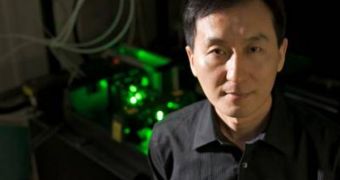Since Ancient times, when irrigation systems were in their early days, people realized the importance of having systems that push water uphill. Since Archimedes and his famous screw that used animals or human power to actively push water up, no clever and sustainable methods of doing this have been found. Taking inspiration from trees, which are able to pump water hundreds of feet into the air, researchers at the University of Rochester have just recently managed to devise a new transportation method, which relies on a simple slab of method and a femtosecond laser system.
[ADMARk=1]The accomplishment, which is detailed in the most recent issue of the journal Applied Physics Letters, could have significant applications in making water flow around a diagnostics chip, cool a computer chip, or turn another piece of metal into an antibacterial surface. All of these applications could potentially revolutionize a number of research fields, but the most promising results could appear in medicine and bioengineering.
“We're able to change the surface structure of almost any piece of metal so that we can control how liquid responds to it. We can even control the direction in which the liquid flows, or whether liquid flows at all,” explains University of Rochester associate professor of optics Chunlei Guo. The new technique, developed by Guo and assistant Anatoliy Vorobyev, basically relies on short pulses of intense laser light, which create nanoscale and microscale pits on the surface of the target slab of metal, upon contact. Globules and strands are also created on the surface of the slab, which add to the control mechanism of the fluid.
“Imagine a huge waterway system shrunk down onto a tiny chip, like the electronic circuit printed on a microprocessor, so we can perform chemical or biological work with a tiny bit of liquid. Blood could precisely travel along a certain path to a sensor for disease diagnostics. With such a tiny system, a nurse wouldn't need to draw a whole tube of blood for a test. A scratch on the skin might contain more than enough cells for a micro-analysis,” the expert explains.
The metal pieces also have the ability to trigger hydrophobia in other metal pieces, a process in which water or other liquids are repelled from the surface of a certain class of materials. Because microscopic organisms, such as microbes, bacteria, or fungi, are mostly made up of water, they cannot adhere to the surface of the hydrophobic material, which basically makes it sterile. At this point, creating such intricate and complex models on a metal surface the size of a coin takes about 30 minutes, but the UR team hopes to reduce that time and increase size through more research.

 14 DAY TRIAL //
14 DAY TRIAL //